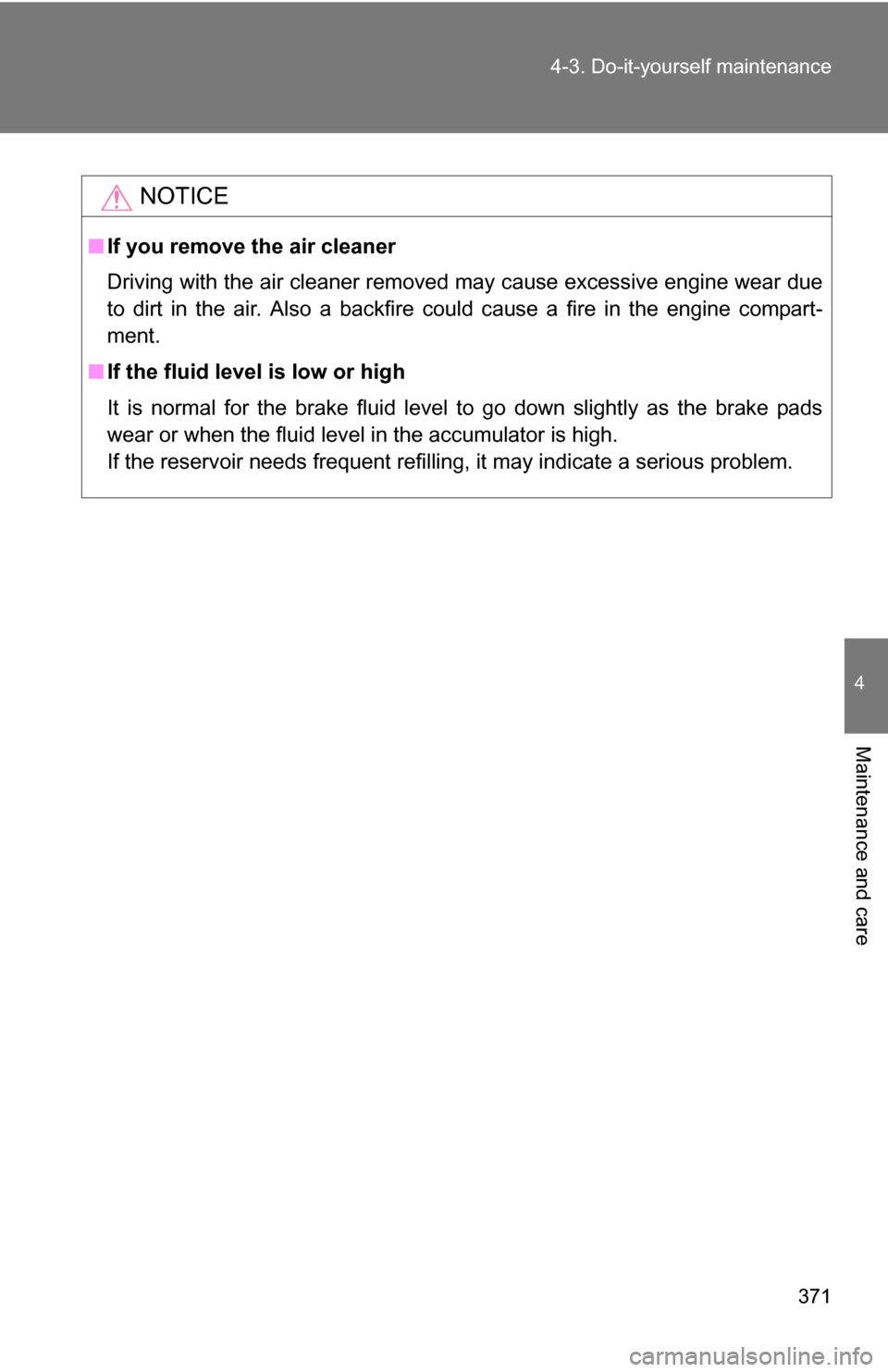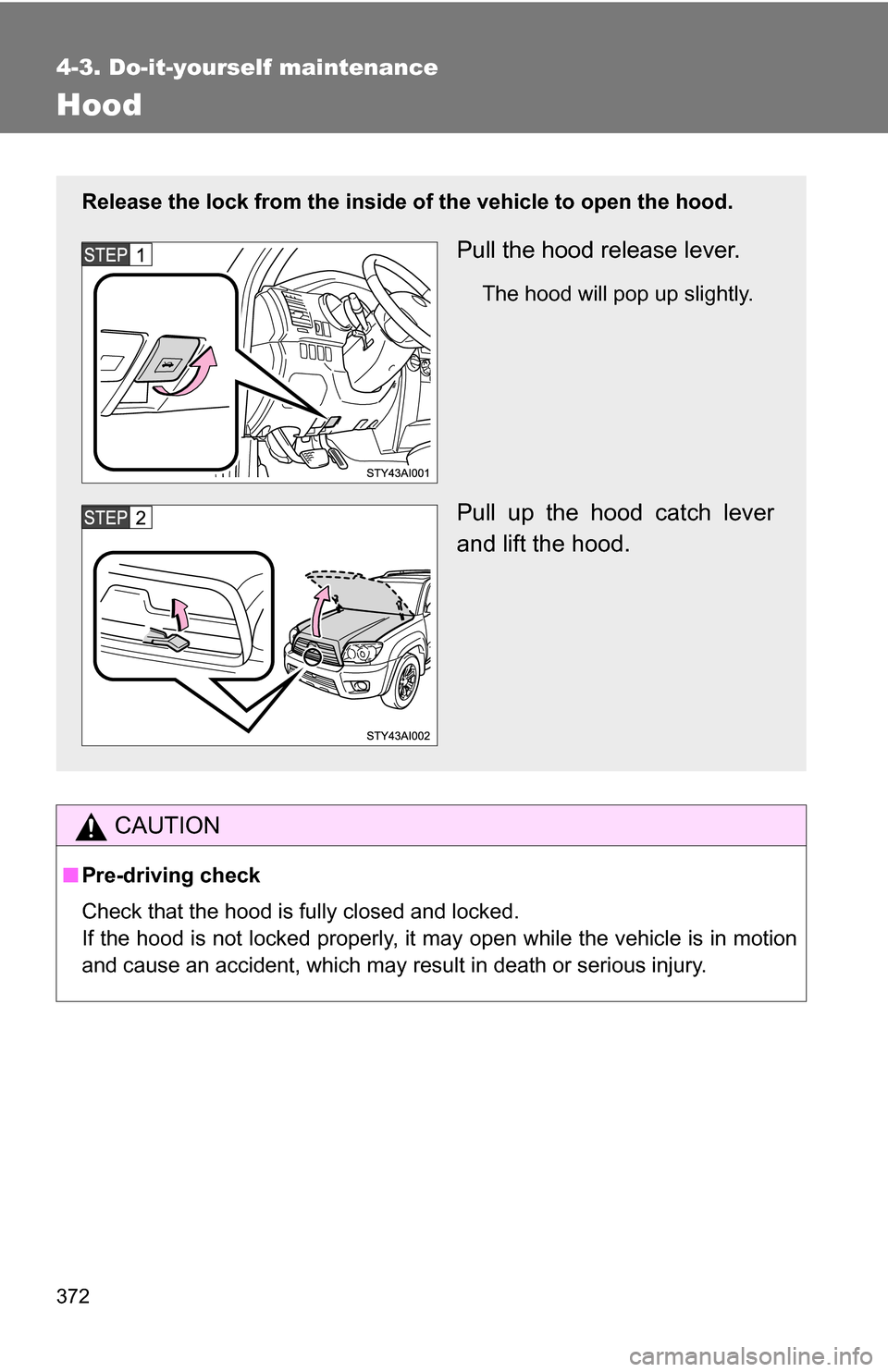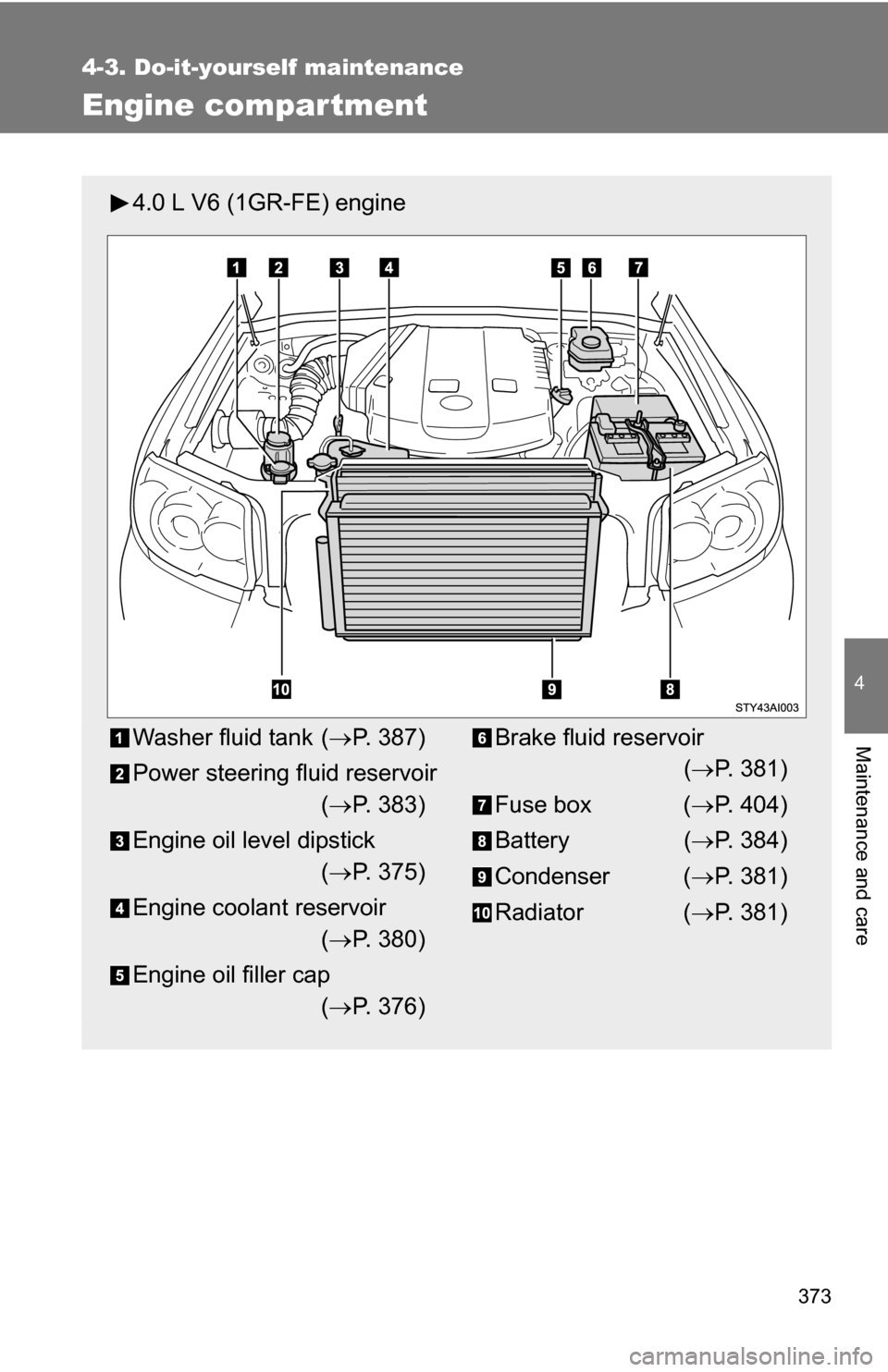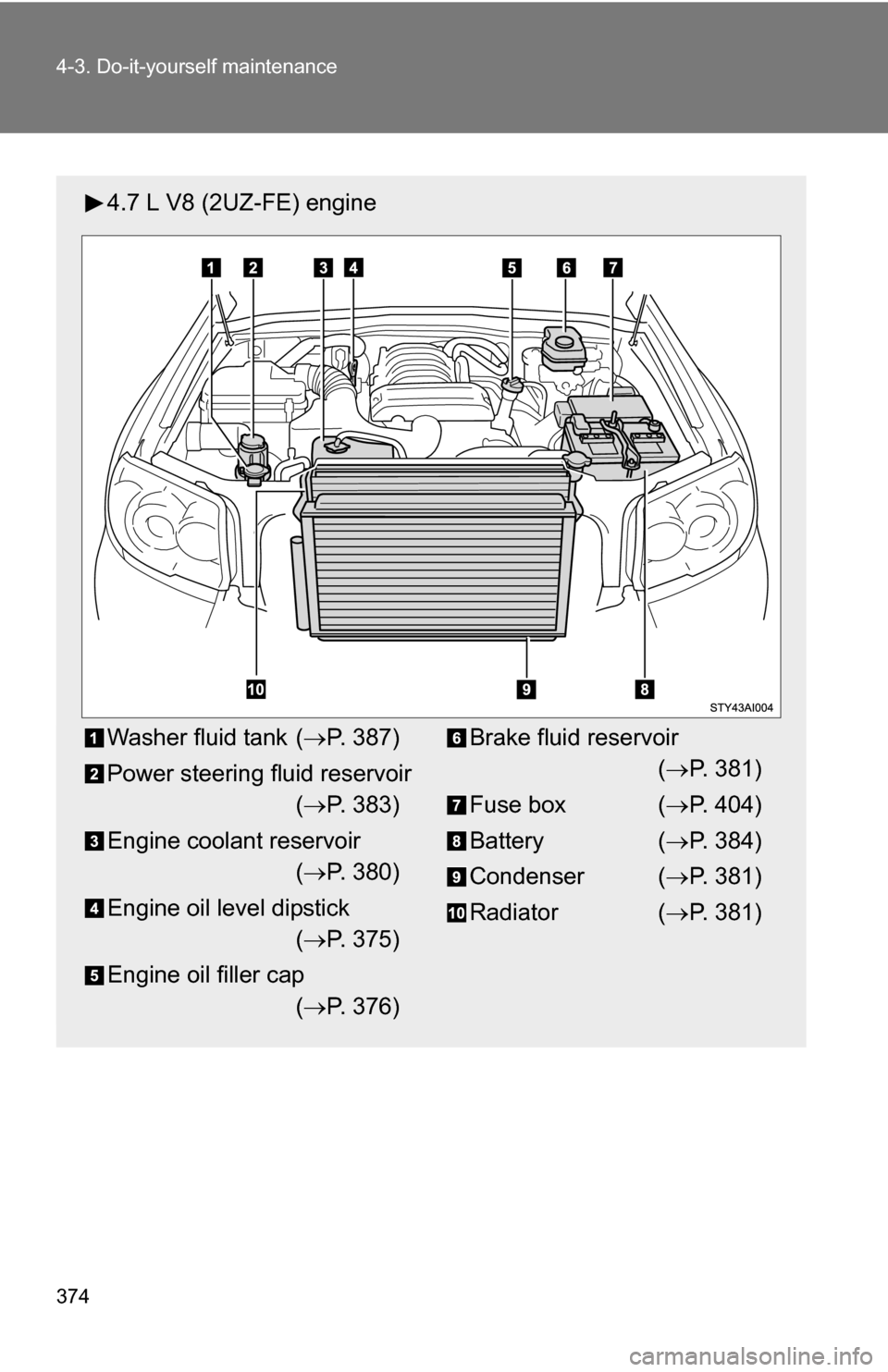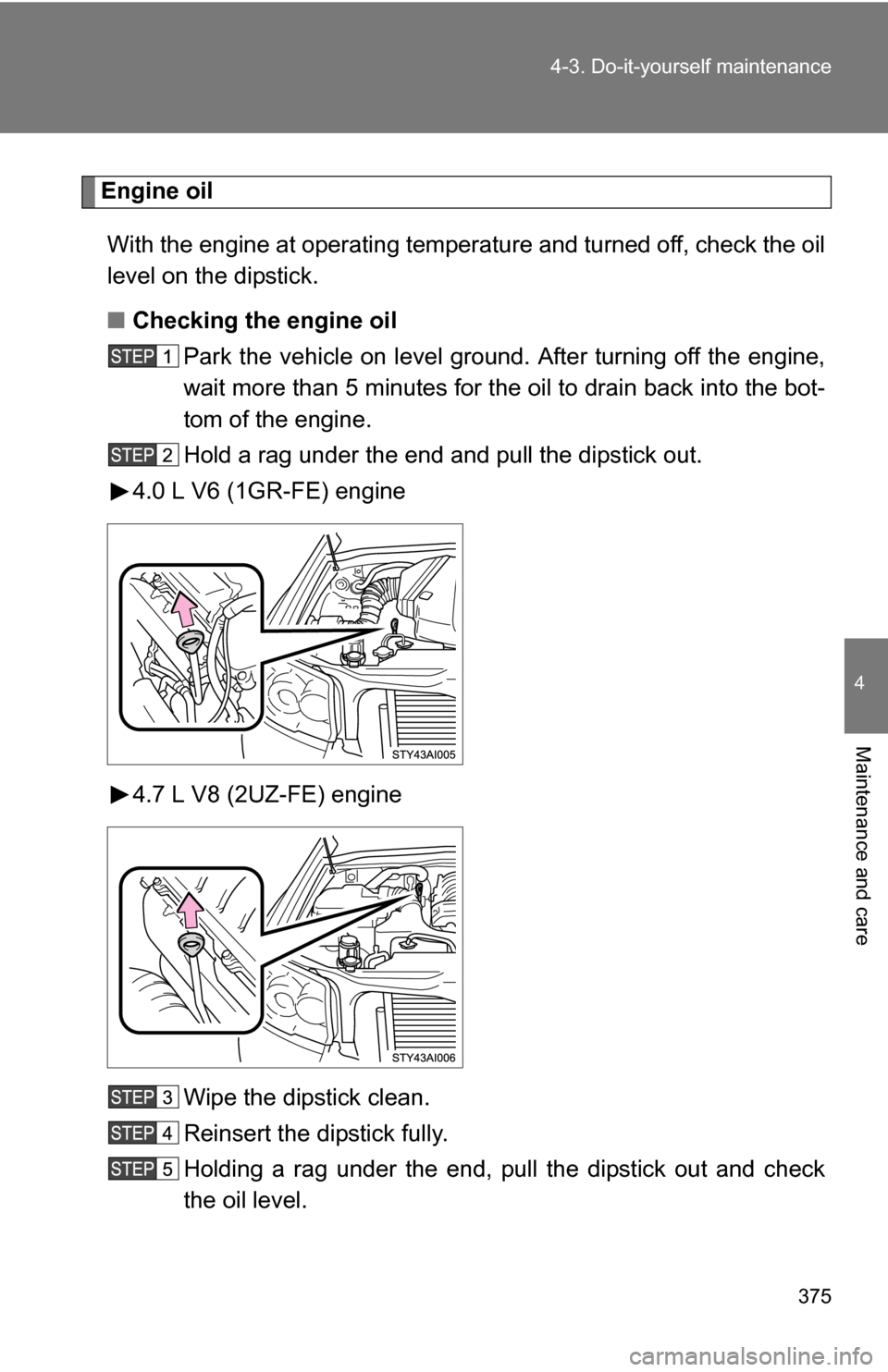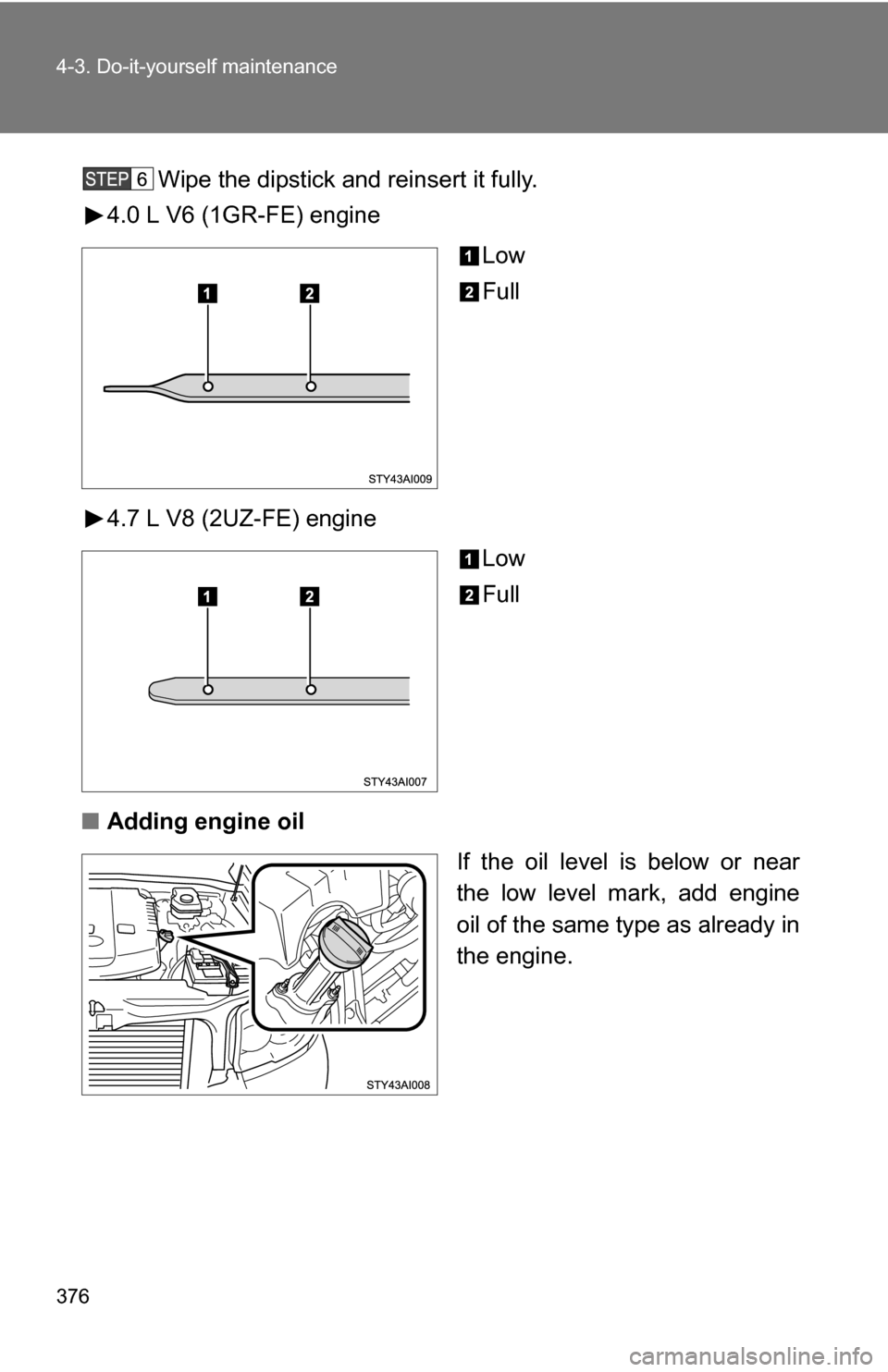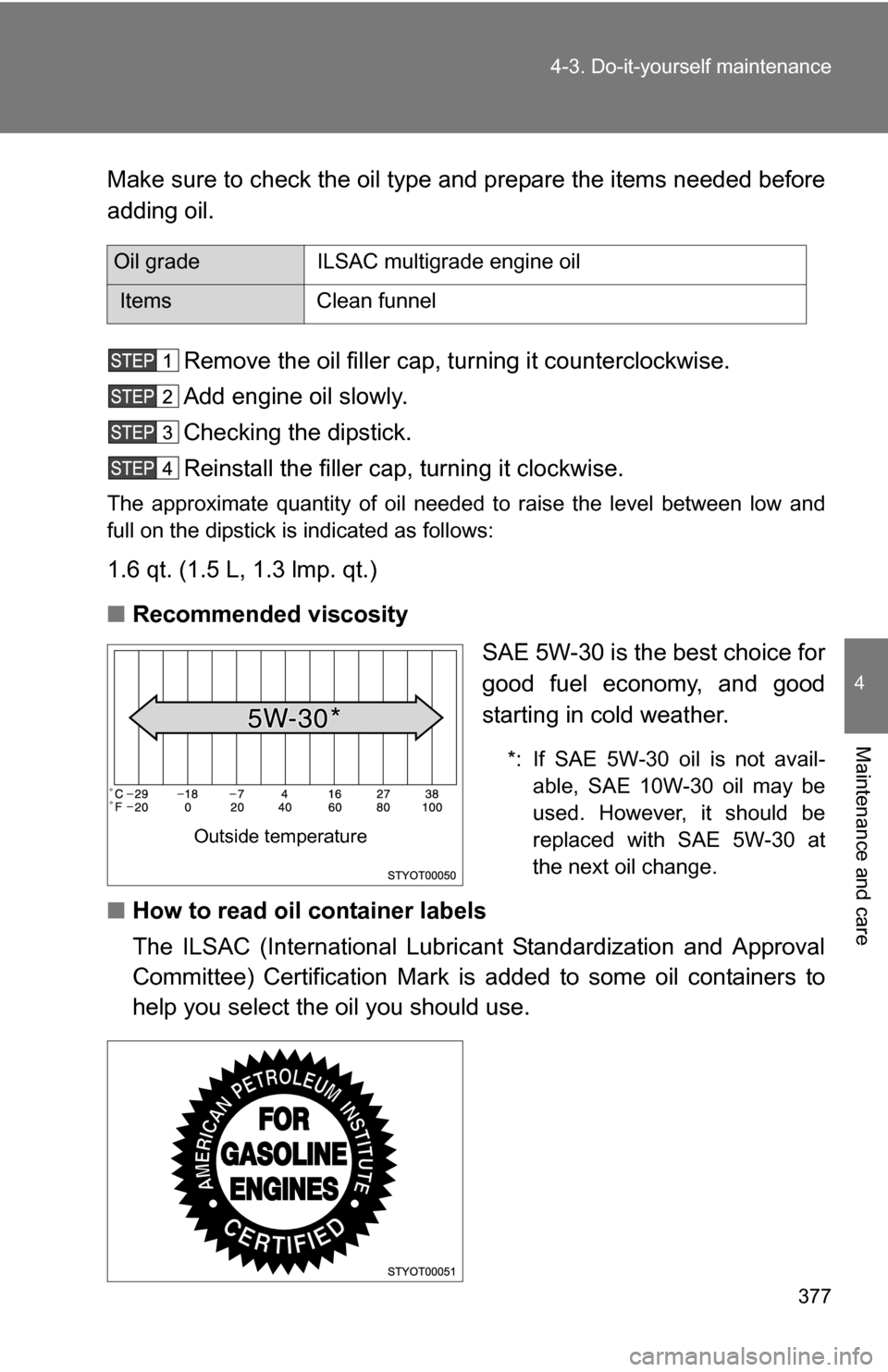TOYOTA 4RUNNER 2009 N280 / 5.G Owners Manual
4RUNNER 2009 N280 / 5.G
TOYOTA
TOYOTA
https://www.carmanualsonline.info/img/14/6094/w960_6094-0.png
TOYOTA 4RUNNER 2009 N280 / 5.G Owners Manual
Trending: maintenance reset, light, tow, stop start, heating, transmission, tire pressure reset
Page 371 of 520
371
4-3. Do-it-yourself maintenance
4
Maintenance and care
NOTICE
■
If you remove the air cleaner
Driving with the air cleaner removed may cause excessive engine wear due
to dirt in the air. Also a backfire could cause a fire in the engine compart-
ment.
■ If the fluid level is low or high
It is normal for the brake fluid level to go down slightly as the brake pads
wear or when the fluid level in the accumulator is high.
If the reservoir needs frequent refilling, it may indicate a serious pro\
blem.
Page 372 of 520
372
4-3. Do-it-yourself maintenance
Hood
CAUTION
■Pre-driving check
Check that the hood is fully closed and locked.
If the hood is not locked properly, it may open while the vehicle is in motion
and cause an accident, which may result in death or serious injury.
Release the lock from the inside of the vehicle to open the hood.
Pull the hood release lever.
The hood will pop up slightly.
Pull up the hood catch lever
and lift the hood.
Page 373 of 520
373
4-3. Do-it-yourself maintenance
4
Maintenance and care
Engine compar tment
4.0 L V6 (1GR-FE) engine
Washer fluid tank (P. 387)
Power steering fluid reservoir ( P. 383)
Engine oil level dipstick ( P. 375)
Engine coolant reservoir ( P. 380)
Engine oil filler cap ( P. 376)Brake fluid reservoir
( P. 381)
Fuse box ( P. 404)
Battery ( P. 384)
Condenser ( P. 381)
Radiator ( P. 381)
Page 374 of 520
374 4-3. Do-it-yourself maintenance
4.7 L V8 (2UZ-FE) engine
Washer fluid tank (P. 387)
Power steering fluid reservoir ( P. 383)
Engine coolant reservoir ( P. 380)
Engine oil level dipstick ( P. 375)
Engine oil filler cap ( P. 376)Brake fluid reservoir
( P. 381)
Fuse box ( P. 404)
Battery ( P. 384)
Condenser ( P. 381)
Radiator ( P. 381)
Page 375 of 520
375
4-3. Do-it-yourself maintenance
4
Maintenance and care
Engine oil
With the engine at operating temperature and turned off, check the oil
level on the dipstick.
■ Checking the engine oil
Park the vehicle on level gro und. After turning off the engine,
wait more than 5 minutes for the oil to drain back into the bot-
tom of the engine.
Hold a rag under the end and pull the dipstick out.
4.0 L V6 (1GR-FE) engine
4.7 L V8 (2UZ-FE) engine
Wipe the dipstick clean.
Reinsert the dipstick fully.
Holding a rag under the end, pull the dipstick out and check
the oil level.
Page 376 of 520
376 4-3. Do-it-yourself maintenance
Wipe the dipstick and reinsert it fully.
4.0 L V6 (1GR-FE) engine
Low
Full
4.7 L V8 (2UZ-FE) engine Low
Full
■ Adding engine oil
If the oil level is below or near
the low level mark, add engine
oil of the same type as already in
the engine.
Page 377 of 520
377
4-3. Do-it-yourself maintenance
4
Maintenance and care
Make sure to check the oil type and prepare the items needed before
adding oil.
Remove the oil filler cap, turning it counterclockwise.
Add engine oil slowly.
Checking the dipstick.
Reinstall the filler cap, turning it clockwise.
The approximate quantity of oil needed to raise the level between low and
full on the dipstick is indicated as follows:
1.6 qt. (1.5 L, 1.3 lmp. qt.)
■ Recommended viscosity
SAE 5W-30 is the best choice for
good fuel economy, and good
starting in cold weather.
*: If SAE 5W-30 oil is not avail-able, SAE 10W-30 oil may be
used. However, it should be
replaced with SAE 5W-30 at
the next oil change.
■How to read oil container labels
The ILSAC (International Lubricant Standardization and Approval
Committee) Certification Mark is added to some oil containers to
help you select the oil you should use.
Oil grade ILSAC multigrade engine oil
ItemsClean funnel
Outside temperature
Page 378 of 520
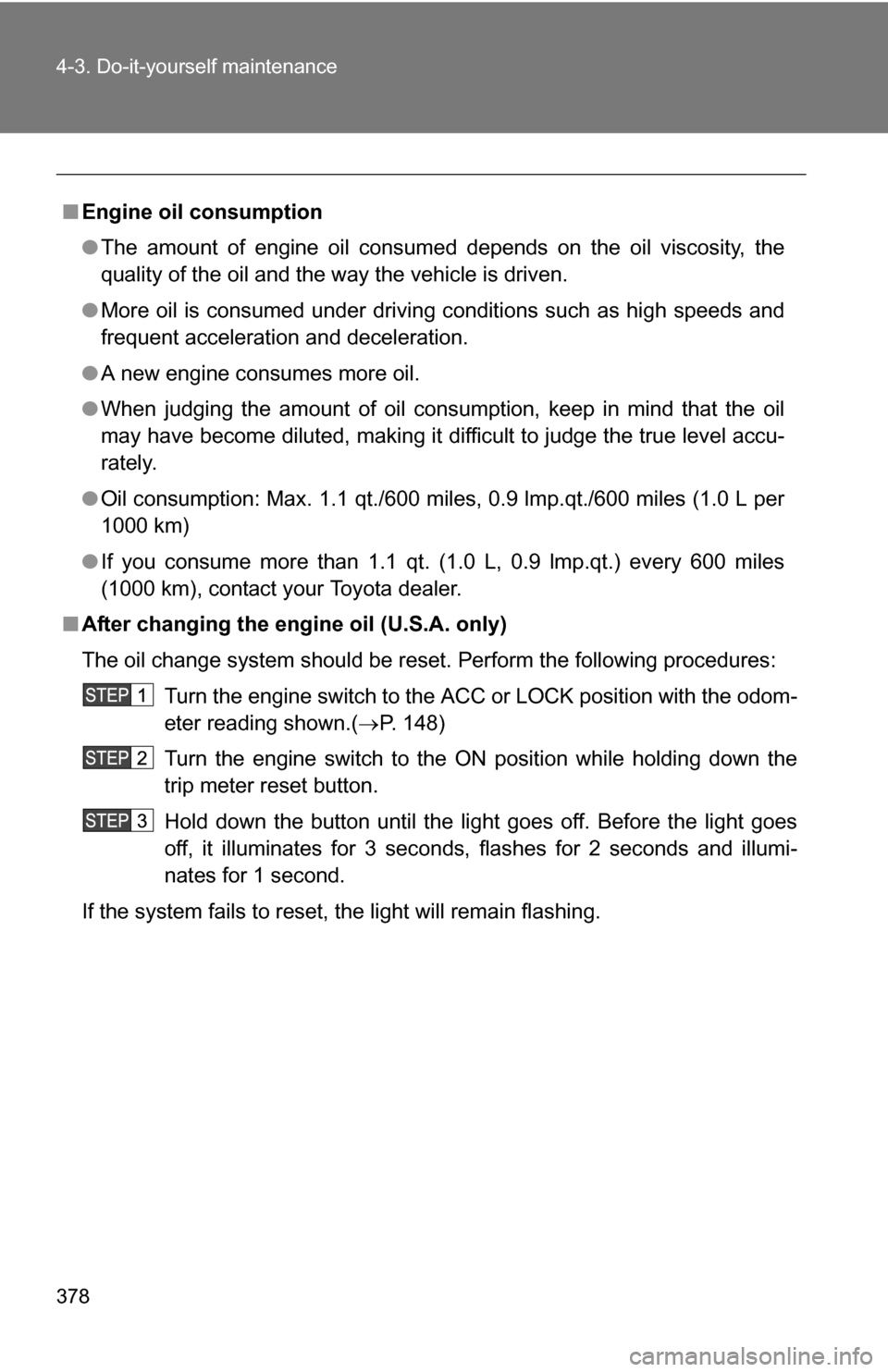
378 4-3. Do-it-yourself maintenance
■Engine oil consumption
●The amount of engine oil consumed depends on the oil viscosity, the
quality of the oil and the way the vehicle is driven.
● More oil is consumed under driving conditions such as high speeds and
frequent acceleration and deceleration.
● A new engine consumes more oil.
● When judging the amount of oil consumption, keep in mind that the oil
may have become diluted, making it difficult to judge the true level accu-
rately.
● Oil consumption: Max. 1.1 qt./600 miles, 0.9 lmp.qt./600 miles (1.0 L per
1000 km)
● If you consume more than 1.1 qt. (1.0 L, 0.9 lmp.qt.) every 600 miles
(1000 km), contact your Toyota dealer.
■ After changing the engine oil (U.S.A. only)
The oil change system should be reset. Perform the following procedures:
Turn the engine switch to the ACC or LOCK position with the odom-
eter reading shown.( P. 148)
Turn the engine switch to the ON position while holding down the
trip meter reset button.
Hold down the button until the light goes off. Before the light goes
off, it illuminates for 3 seconds, flashes for 2 seconds and illumi-
nates for 1 second.
If the system fails to reset, the light will remain flashing.
Page 379 of 520
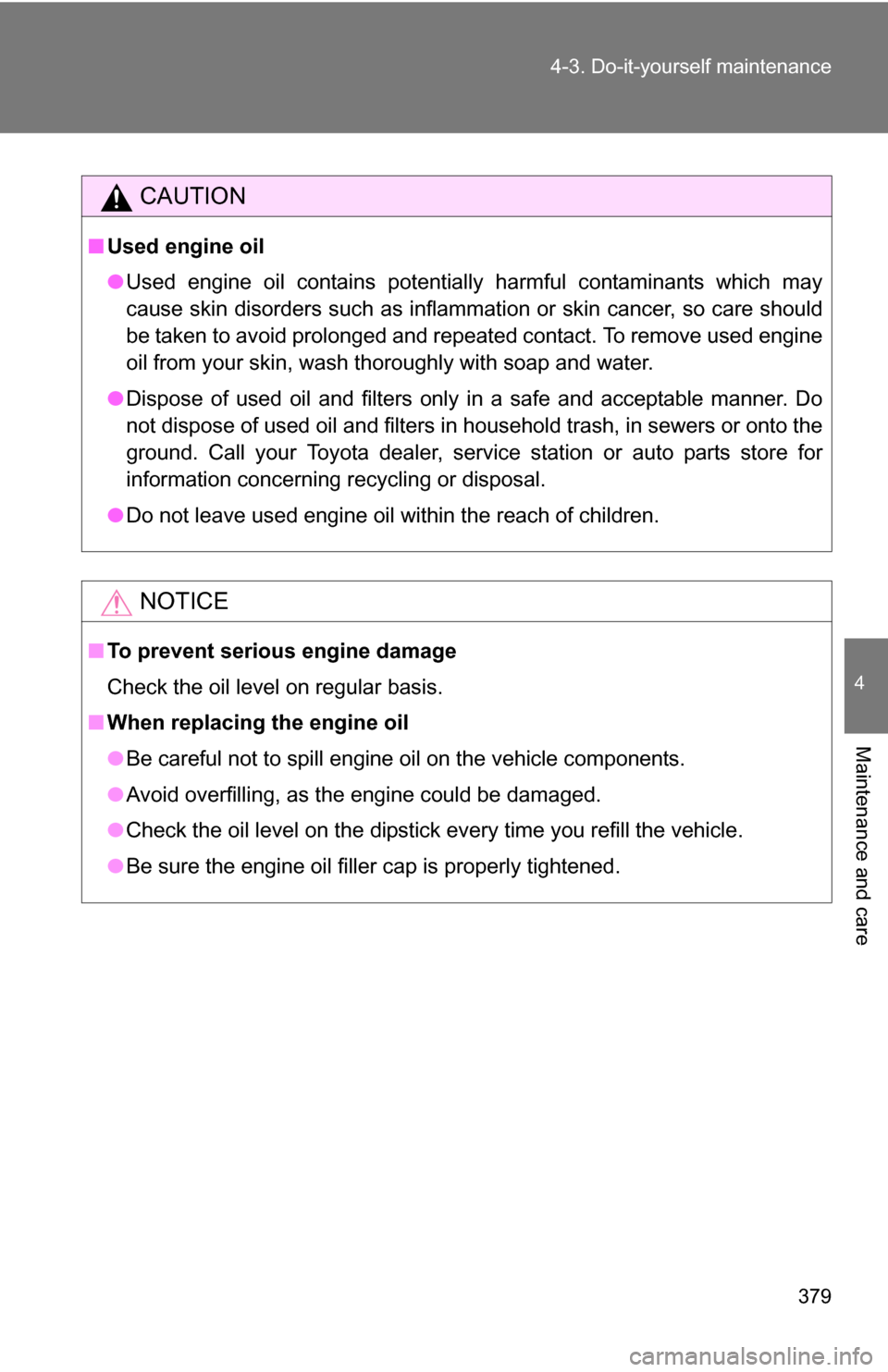
379
4-3. Do-it-yourself maintenance
4
Maintenance and care
CAUTION
■
Used engine oil
●Used engine oil contains potentially harmful contaminants which may
cause skin disorders such as inflammation or skin cancer, so care should
be taken to avoid prolonged and repeated contact. To remove used engine
oil from your skin, wash thoroughly with soap and water.
● Dispose of used oil and filters only in a safe and acceptable manner. Do
not dispose of used oil and filters in household trash, in sewers or onto the
ground. Call your Toyota dealer, service station or auto parts store for
information concerning recycling or disposal.
● Do not leave used engine oil within the reach of children.
NOTICE
■To prevent serious engine damage
Check the oil level on regular basis.
■ When replacing the engine oil
●Be careful not to spill engine oil on the vehicle components.
● Avoid overfilling, as the engine could be damaged.
● Check the oil level on the dipstick every time you refill the vehicle.
● Be sure the engine oil filler cap is properly tightened.
Page 380 of 520
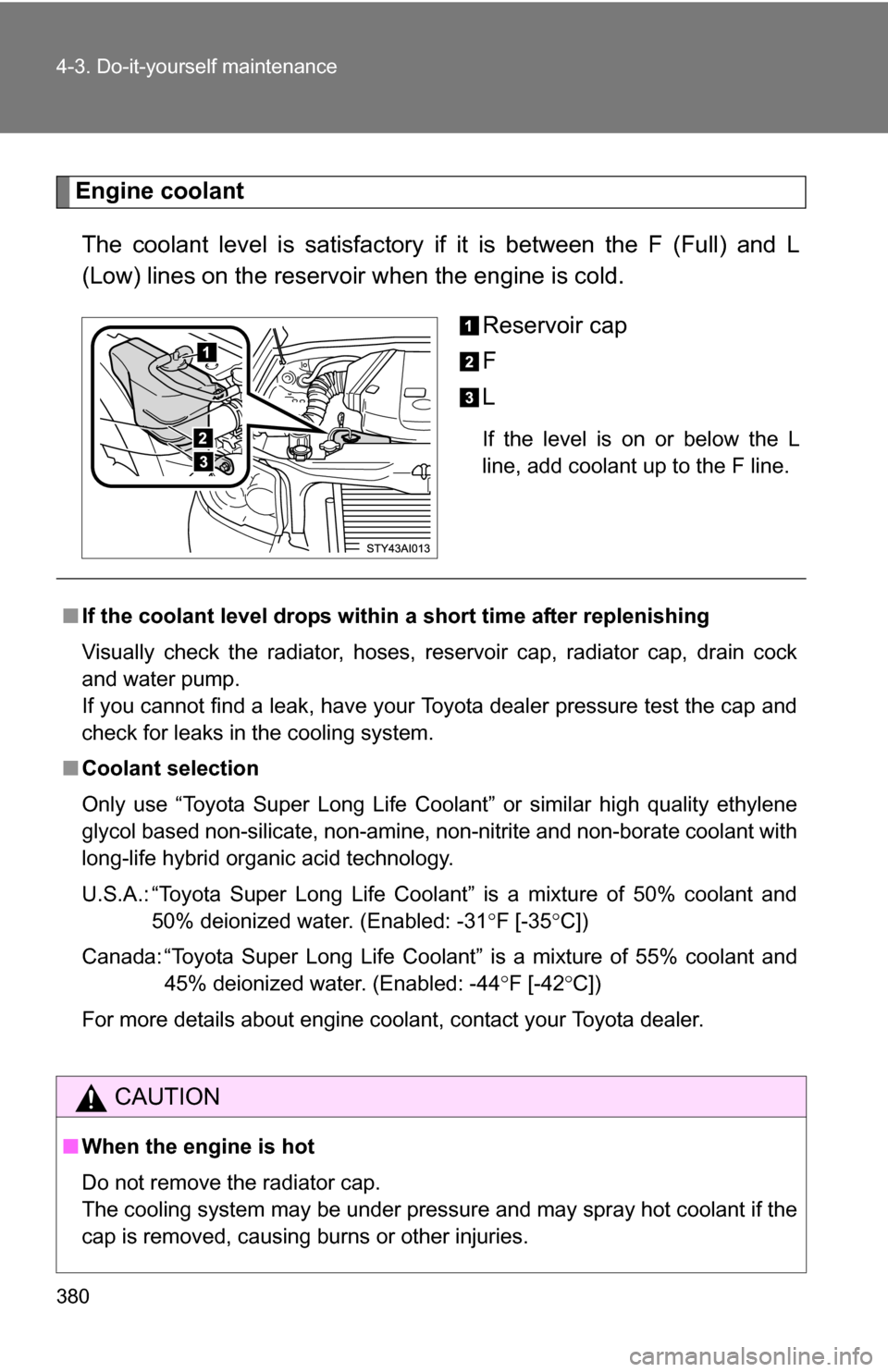
380 4-3. Do-it-yourself maintenance
Engine coolantThe coolant level is satisfactory if it is between the F (Full) and L
(Low) lines on the reservoir when the engine is cold. Reservoir cap
F
L
If the level is on or below the L
line, add coolant up to the F line.
■If the coolant level drops within a short time after replenishing
Visually check the radiator, hoses, reservoir cap, radiator cap, drain cock
and water pump.
If you cannot find a leak, have your Toyota dealer pressure test the cap and
check for leaks in the cooling system.
■ Coolant selection
Only use “Toyota Super Long Life Coolant” or similar high quality ethylene
glycol based non-silicate, non-amine, non-nitrite and non-borate coolant with
long-life hybrid organic acid technology.
U.S.A.: “Toyota Super Long Life Coolant” is a mixture of 50% coolant and
50% deionized water. (Enabled: -31 F [-35 C])
Canada: “Toyota Super Long Life Coolant” is a mixture of 55% coolant and 45% deionized water. (Enabled: -44 F [-42 C])
For more details about engine coolant, contact your Toyota dealer.
CAUTION
■ When the engine is hot
Do not remove the radiator cap.
The cooling system may be under pressure and may spray hot coolant if the
cap is removed, causing burns or other injuries.
Trending: charging, homelink, height adjustment, open hood, jump start, fog light, traction control
